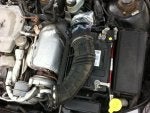Hi everyone,
Since there wasn't much information about that kind of job and it seemed to me to be a real PITA, I just thought that creating my first How To thread would be a great idea.
Advise: English is not my primary language, I'm sorry for any inconvenience.
First things first, when you pop the hood, you should see something like this with more or less dirt. If not, this is not for you.
![]()
1. You will need a couple of Torx bits, a ratchet set, Jack and stand, the new sensor and a strange 27mm offset key (I used a table saw key that I bent).
2. Remove the turbo inlet pipe that comes from the air filter across the engine to the turbo. You will have to unscrew 2 tors bolts, the collars and unplug some hoses and connectors. You will have to separate the 2 hoses since it's easier to remove this way. The one that connects to the turbo I've just set aside, there was a hose I couldn't disconnect and didn't want to brake anything.
![]()
![]()
3. Remove the hose that plugs into the throttle body. Again there is some stuff to disconnect.
![]()
4. Unscrew the 2 torx bolts that hold the pipe in front of the engine. It actually hides the sensor's area. It was quite impossible to take a good picture of where the screws were. You will have to figure out on your own.;ol;
![]()
Since there wasn't much information about that kind of job and it seemed to me to be a real PITA, I just thought that creating my first How To thread would be a great idea.
Advise: English is not my primary language, I'm sorry for any inconvenience.
First things first, when you pop the hood, you should see something like this with more or less dirt. If not, this is not for you.

1. You will need a couple of Torx bits, a ratchet set, Jack and stand, the new sensor and a strange 27mm offset key (I used a table saw key that I bent).
2. Remove the turbo inlet pipe that comes from the air filter across the engine to the turbo. You will have to unscrew 2 tors bolts, the collars and unplug some hoses and connectors. You will have to separate the 2 hoses since it's easier to remove this way. The one that connects to the turbo I've just set aside, there was a hose I couldn't disconnect and didn't want to brake anything.


3. Remove the hose that plugs into the throttle body. Again there is some stuff to disconnect.

4. Unscrew the 2 torx bolts that hold the pipe in front of the engine. It actually hides the sensor's area. It was quite impossible to take a good picture of where the screws were. You will have to figure out on your own.;ol;














